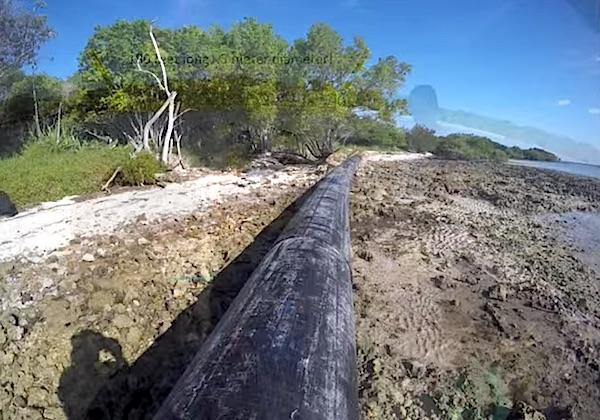
It wasn't easy, but after five days of sweating crews were able to turn this 180-foot-long pipeline into more bite-sized pieces to remove it from Elliott Key a Biscayne National Park/NPS.
It's not every day that a 180-foot-long, 6,000-pound plastic pipe washes ashore in a national park. But that's what happened recently at Elliott Key in Biscayne National Park in Florida. What follows is the story of how it was removed by a band of volunteers.
The pipe washed up onto a beach that sea turtles nest, creating the need, with nesting season coming soon, to get the pipe out of there.
'A massive piece of marine debris is no longer littering nesting habitat for threatened and endangered sea turtles,' said Elsa Alvear, Biscayne's chief of resource management, after the pipe was hauled away in pieces. 'As an added bonus, a large volume of plastic has been kept out of local landfills thanks to creative recycling efforts.'
Removing the pipe from Elliott Key required a team effort among park employees, volunteers, university students, government agencies and private organizations. The pipe was made of hard plastic between one and two inches thick and almost a 18 inches in diameter, according to park staff.
Lloyd Brown of Miami-Dade Fire Rescue used a chainsaw to cut the pipe into 62 pieces. Each piece was between 2 and 5 feet long and weighed from 60 to 100 pounds. Volunteers, who including students from the University of Miami and Tulane University, rolled the pieces into the ocean and then onto boats. The challenging work took five days to complete.
With sea turtle nesting season just around the corner, leaving the pipe on the beach was not an option. Large objects like this pipe create insurmountable obstacles for sea turtles. Sea turtles come ashore to nest in the park between May and October.
While the origins of the pipe are a mystery, Miami-Dade County confirmed that the pipe was not the type used by the Port of Miami dredging project.
Some of the pipe pieces were transferred to Wildlife Rescue of Dade County, where they will be fashioned into dens for injured and orphaned animals. Animals that may use the dens include bobcats, foxes, and rabbits. The same pipe that once threatened wildlife will now help wildlife. TruGreen Plastics Corporation recycled the remainder of the pieces.



Add comment